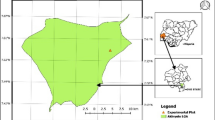Summary
Changes in the carbon, hydrogen, nitrogen and polyphenol content of chestnut and beech leaves were measured during the first year after fall.
Chestnut leaves had an initial carbon, hydrogen and nitrogen content (by weight) of 48.71%, 5.56% and 0.77% respectively; beech had a similar carbon and hydrogen content (47.77% and 5.36%) but less nitrogen (0.56%).
Both leaf litter types showed percentage increases in nitrogen content during the study period but only the beech showed absolute increases in nitrogen content of up to 66.7% of the initial weight present in the leaves. The percentage increases in the nitrogen content of chestnut litter were largely attributable to more rapid losses of non-nitrogenous leaf constituents while the weight of nitrogen present in the leaves remained relatively constant.
The percentage carbon and hydrogen contents of the chestnut and beech litter showed changes of less than 1% throughout the year, indicating that carbohydrate losses were directly proportional to weight losses.
Soil animals fed on chestnut leaves to a far greater extent than beech leaves; this difference did not appear to be directly attributable to differences between the nitrogen contents or C/N ratios of the two leaf litter species. The gross polyphenol contents of chestnut and beech litter showed an intraspecific inverse correlation with the feeding activities of soil animals on the leaves, but did not account for interspecific differences in leaf palatability since chestnut leaves were eaten when they contained higher polyphenol concentrations than beech leaves. However, there was an interspecific negative correlation between palatability and the presence of protocatechuic and gallic acids.
Similar content being viewed by others
References
Anderson, J. M.: The breakdown and decomposition of sweet chestnut (Castanea sativa Mill.) and beech (Fagus sylvatica L.) leaf litter in two deciduous woodland soils. I. Breakdown, leaching and decomposition. Oecologia 12, 251–274 (1973a).
Anderson, J. M.: Carbon dioxide evolution from two temperate, deciduous woodland soils. J. Appl. Ecol. 10, 359–376 (1973b).
Bloomfield, C.: Organic matter and soil dynamics. In: Experimental pedibiology, E. G. Hallsworth, D. U. Crawford, Eds., p. 275–266. London: Butterworth 1965.
Bocock, K. L.: Changes in the amount of nitrogen in decomposing leaf litter of sessile oak (Quercus petraea). J. Ecol. 51, 555–556 (1963).
Bocock, K. L.: Changes in the amounts of dry matter, nitrogen, carbon and energy in decomposing woodland leaf litter in relation to the activities of the soil fauna. J. Ecol. 52, 273–284 (1964).
Coldwell, B. B., Delong, W. A.: Studies of the decomposition of deciduous forest tree leaves before and after partial decomposition. Canad. J. Agric. Sci. 30, 456–466 (1950).
Daubenmire, R., Prusso, D. C.: Studies on the decomposition rates of tree litter. Ecology 44, 589–592 (1963).
Edwards, C. A., Heath, G. W.: The rôle of soil animals in the breakdown of leaf material. In: Soil organisms, J. Doeksen, J. van der Drift, Eds., p. 76–85. Amsterdam: North Holland 1963.
Gilbert, O., Bocock, K. L.: Changes in leaf litter when placed on the surface of soils with contrasting humus types. II. Changes in the nitrogen content of oak and ash litter. J. Soil. Sci. 11, 10–19 (1960).
Handley, W. R. C.: Mull and mor formation in relation to forest soils. For. Comm. Bull. 23, 115 p. London: H. M. S. O. 1954.
Harley, J. L.: Fungi in ecosystems. J. Anim. Ecol. 41, 1–16 (1972).
Hathway, D. E.: Plant polyphenols and tannins. In: Chromatographic and eletrophoretic techniques, vol. 1. Chromatography, I. Smith, Ed., p. 308–354. London: Heinemann 1960.
Heath, G. W., King, H. G. C.: Litter breakdown in deciduous forest soils. 8th Int. Congr. Soil Sci. 3, 979–987 (1964).
King, H. G. C., Heath, G. W.: The chemical analysis of small samples of leaf material and the relationship between the disappearance and composition of leaves. Pedobiologia 7, 192–197 (1967).
Kowal, N. E.: Effect of leaching on pine litter decomposition rate. Ecology 50, 739–740 (1969).
Melin, E.: Biological decomposition of some types of litter from North American forests. Ecology 11, 72–101 (1930).
Mikola, P.: Experiments on the ability of forest soil basidiomycetes to decompose litter material. Ecology 11, 72–101 (1954).
Monnier, G., Jeanson, C.: Studies on the stability of soil structure: influence of moulds and soil fauna. In: Experimental pedology, E. G. Hallsworth, D. U. Crawford, Eds., p. 244–254. London: Butterworths 1964.
Nykvist, N.: Leaching and decomposition of litter. IV. Experiments on needle litter of Picea abies. Oikos 12, 264–279 (1961).
Olsen, C.: Studies of nitrogen fixation. 1. Nitrogen fixation in dead leaves of forest beds. C. R. Lab. Calsberg 19, 1–36 (1933).
Satchell, J. E., Lowe, D. G.: Selection of leaf litter by Lumbricus terrestris. In: Progress in soil biology, O. Graff, J. E. Satchell, Eds., p. 102–119. Amsterdam: North Holland 1966.
Tenney, F. G., Waksman, S. A.: Composition of natural organic materials and their decomposition in the soil. IV. The nature and rapidity of decomposition of the various organic complexes in different plant materials under aerobic conditions. Soil. Sci. 28, 55–84 (1929).
Waksman, S. A., Gerretsen, F. C.: Influence of temperature and moisture upon the nature and extent of decomposition of plant residues by micro-organisms. Ecology 12, 33–60 (1931).
Waksman, S. A., Tenney, F. G.: Composition of natural organic materials and their decomposition in the soil. III. The influence of nature of plant upon the rapidity of its decomposition. Soil Sci. 26, 155–171 (1928).
Witkamp, M.: Decomposition of leaf litter in relation to environment, microflora and microbial respiration. Ecology 47, 194–201 (1966).
Author information
Authors and Affiliations
Rights and permissions
About this article
Cite this article
Anderson, J.M. The breakdown and decomposition of sweet chestnut (Castanea sativa mill.) and beech (Fagus sylvatica L.) leaf litter in two deciduous woodland soils. Oecologia 12, 275–288 (1973). https://doi.org/10.1007/BF00347567
Received:
Issue Date:
DOI: https://doi.org/10.1007/BF00347567




